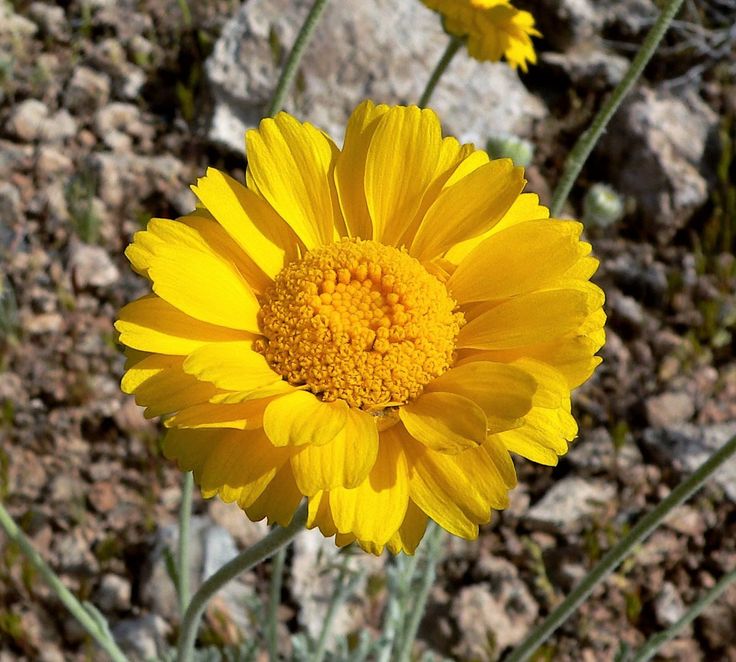Baileya multiradiata
Baileya multiradiata, commonly known as Desert Marigold, is a charming perennial herb native to the southwestern United States and northern Mexico.
Renowned for its bright yellow flowers and drought-tolerant nature, Desert Marigold adds a splash of color and resilience to arid landscapes.
In this comprehensive article, we will delve into the botanical intricacies, habitat preferences, life cycle, ecological and cultural importance, conservation status, and care guidelines for Baileya multiradiata.
Botanical Description
Desert Marigold is a member of the aster family (Asteraceae) and typically grows to heights of 1 to 2 feet. It features slender, branching stems adorned with deeply lobed, gray-green leaves that are coated with fine hairs, giving them a silvery appearance.
The foliage forms a compact mound, providing a striking contrast to the vibrant yellow flowers. The daisy-like flowers of Desert Marigold are composed of numerous ray florets surrounding a central disk, creating a cheerful and sunny display.
Flowering occurs throughout the spring and summer months, with individual flowers lasting several weeks.
Habitat and Distribution
Desert Marigold is native to arid and semi-arid regions, including deserts, grasslands, and rocky slopes.
It occurs throughout the southwestern United States, including Arizona, California, Nevada, New Mexico, Texas, and Utah, as well as parts of northern Mexico.
Desert Marigold thrives in full sunlight and well-drained, sandy, or gravelly soils. It is often found growing in open, sunny locations.
It thrives in hot, dry conditions, commonly appearing along roadsides, in xeriscape gardens, and in naturalized landscapes.
Life Cycle and Phenology
As a perennial herb, Desert Marigold exhibits a relatively long life cycle compared to annual plants.
Growth typically occurs in response to rainfall, with new foliage and flower buds emerging from dormant buds as temperatures rise and moisture levels increase.
Flowering peaks in the spring and summer months, although sporadic blooms may occur throughout the year in response to favorable conditions.
Desert Marigold thrives in drought conditions, withstanding prolonged periods of heat and dryness by conserving water in its fleshy leaves and deep root system.
Ecological and Cultural Importance
Desert Marigold plays a valuable ecological role in its native habitat, providing food and habitat for a variety of wildlife species.
The flowers are a valuable nectar source for bees, butterflies, and other pollinators, supporting pollinator populations and promoting biodiversity.
Additionally, birds and small mammals consume the seeds, contributing to the food web in arid ecosystems.
Culturally, Desert Marigold has been admired for its cheerful blooms and used in native plant landscaping, wildflower gardens, and floral arrangements.
Its ability to thrive in hot, dry conditions makes it a popular choice for water-wise gardens and landscapes.

Caring for Baileya multiradiata
Sunlight
Plant Desert Marigold in a location that receives full sunlight, as it prefers abundant sunlight for optimal growth and flowering.
Watering
Water young plants regularly during the first growing season to establish a strong root system.
Once established, Desert Marigold is drought tolerant and generally requires minimal irrigation.
Water deeply during prolonged dry spells, especially in sandy or gravelly soils.
Soil
Plant in well-drained, sandy or gravelly soil with good drainage.
Desert Marigold adapts to arid conditions and cannot tolerate waterlogged soils.
Avoid heavy clay soils, which can cause root rot and other problems.
Pruning
Desert Marigold does not require pruning except to remove spent flower stems or to tidy up the plant's appearance.
Deadhead spent flowers to encourage continued blooming throughout the season.
Fertilizing
Desert Marigold generally does not require fertilization, especially in nutrient-poor soils.
If desired, apply a balanced fertilizer sparingly in spring, following the manufacturer's instructions.
Mulching
Apply a layer of organic mulch around the base of the plant to help retain moisture, suppress weeds, and insulate the roots from temperature fluctuations.
Avoid placing mulch directly against the stem to prevent rot and fungal diseases.
Following these care guidelines enables the cultivation of vibrant Desert Marigold, enhancing arid landscapes and conserving native plant species.
Leave a Reply
You must be logged in to post a comment.